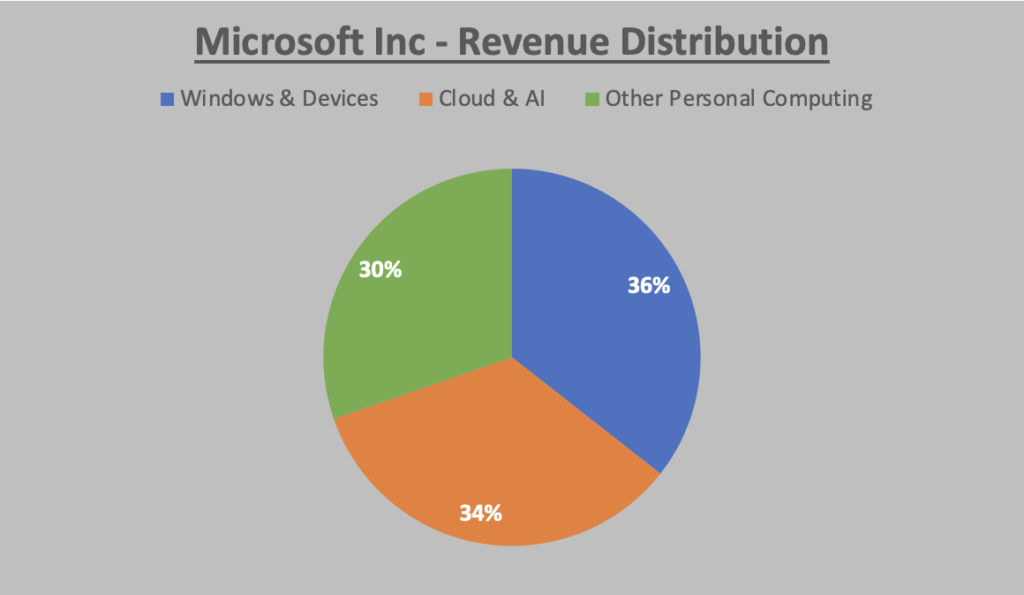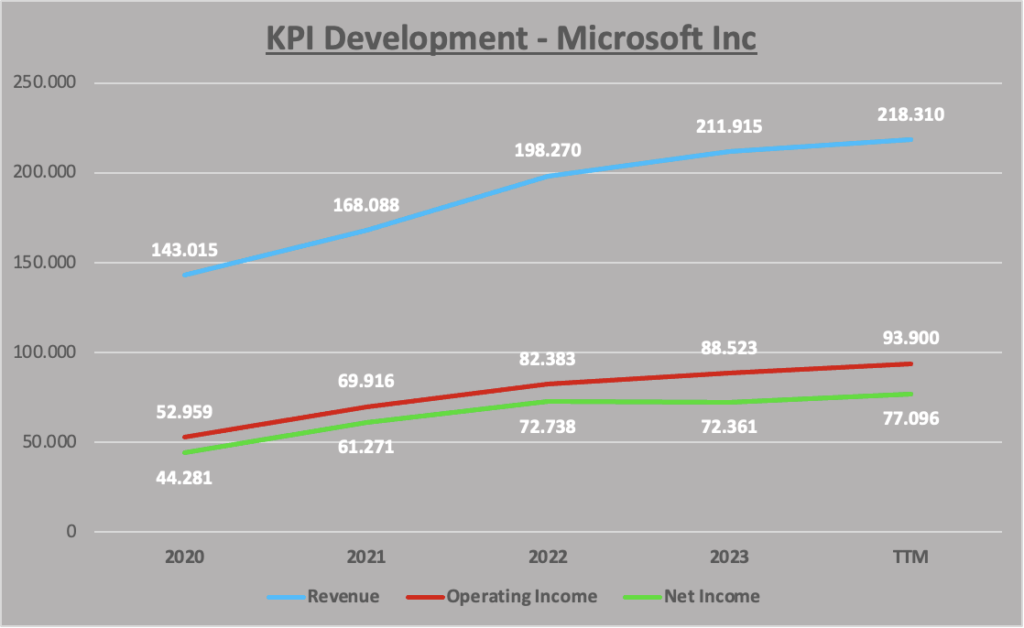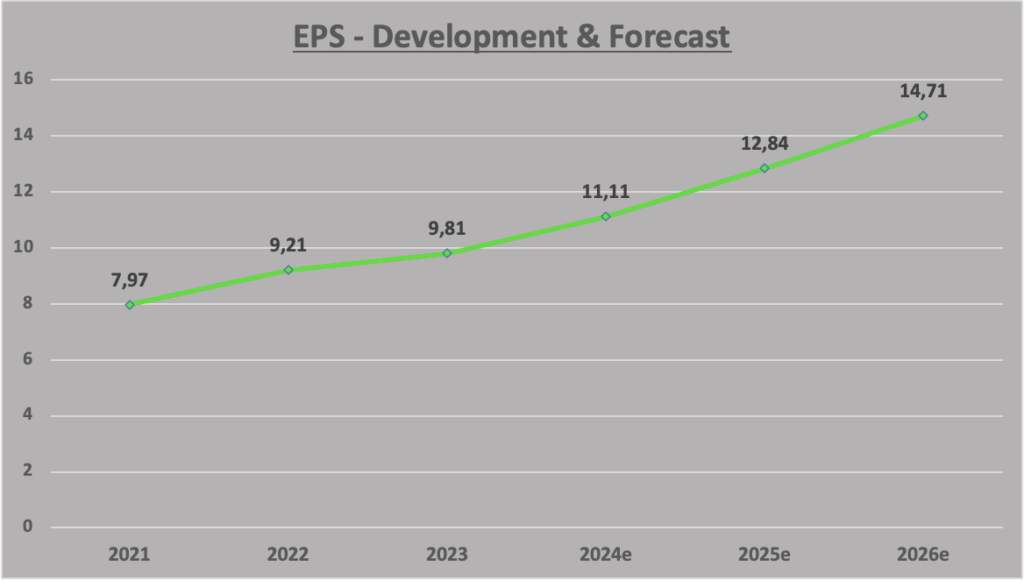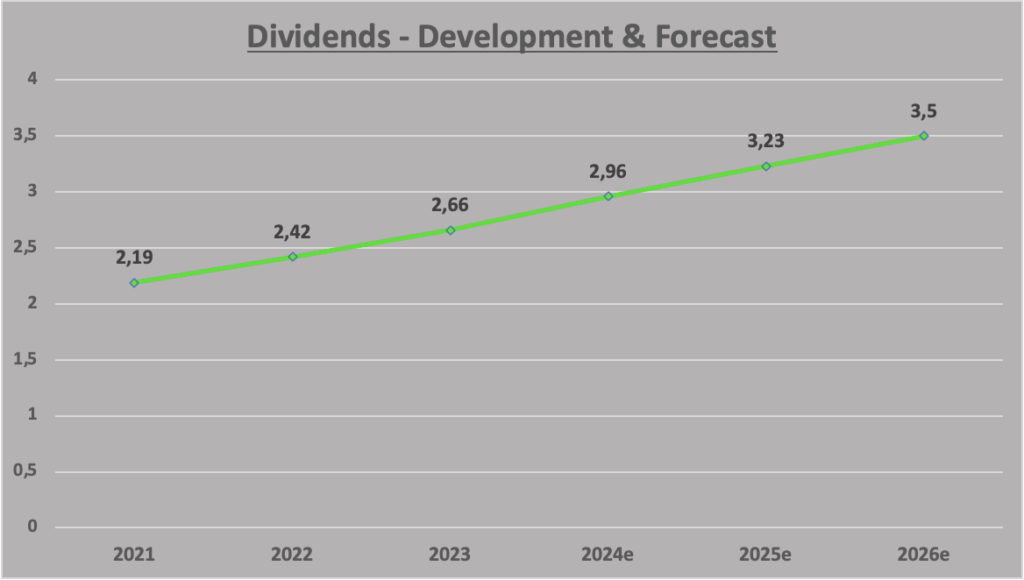In this stock analysis we will learn everything about the Microsoft share. We will analyze Microsoft’s profitability, financial security & growth and in the end we will evaluate the share price. You can then decide whether Microsoft is a suitable investment for you or not.
Company profile
Microsoft Corporation is a multinational technology company headquartered in Redmond, Washington. It is the world’s largest software company and one of the most valuable companies in the world. The company offers a wide range of products and services, including operating systems, office software, cloud computing services, game consoles and consumer electronics.
Leading products and services:
- Operating systems: Windows, Windows Server, Azure Stack Hub
- Office software: Microsoft Office, Microsoft 365
- Cloud computing services: Azure, Dynamics 365, Power Platform
- Games consoles: Xbox Series X/S, Xbox One
- Consumer electronics: Surface devices, HoloLens
Microsoft is a well-positioned company to be successful in the future. The company is a leader in a number of growth markets, including cloud computing and artificial intelligence. In addition, Microsoft has a strong brand and a loyal customer base.
Revenue Distribution – Microsoft Inc
Microsoft divides its business into three divisions:
Windows & Devices
This division comprises the development and sale of operating systems, hardware and services for consumers and companies. The main sales driver is the Windows operating system, which runs on over 1.5 billion devices worldwide. This division also includes the Surface, Xbox and Dynamics product lines.
Cloud & AI
This division comprises the development and sale of cloud computing services and artificial intelligence. The main sales driver is the Azure cloud computing service, which is one of the world’s leading cloud platforms. This division also includes the Dynamics 365 and Power Platform product lines.
More Personal Computing
This business division comprises the development and sale of software products and services for consumers. The main sales driver is the office software package Office, which is used on over 1.2 billion devices worldwide. This division also includes the Bing, MSN and LinkedIn product lines.
Revenue from the three divisions is broken down as follows:

Microsoft’s revenue distribution has shifted significantly in favor of the cloud and AI business area in recent years.
The cloud and AI business area is a growth market with high growth rates. The global market for cloud computing is expected to grow to $832.1 billion by 2026.
These growth markets offer Microsoft good opportunities for future growth. The company is well positioned in these markets to expand its position as market leader.
Competition
Microsoft’s biggest and most important competitors are:
Amazon is a global technology company active in a variety of areas, including cloud computing, e-commerce, artificial intelligence and entertainment. Amazon is Microsoft’s biggest competitor in the cloud computing market.
Google is a global technology company active in a variety of areas, including search engines, advertising, cloud computing and artificial intelligence. Google is Microsoft’s biggest competitor in the search engine market and in the field of artificial intelligence.
Apple is a global technology company operating in a variety of areas, including hardware, software, entertainment and digital services. Apple is Microsoft’s biggest competitor in the hardware sector, particularly in the area of personal computers.
In addition, the following two companies are competitors of Microsoft:
IBM is a global technology company active in a variety of areas, including cloud computing, artificial intelligence, software and hardware.
Salesforce is a global provider of cloud-based software solutions for businesses. Salesforce is a competitor of Microsoft in the cloud-based enterprise software space.
Competition between Microsoft and these companies has become increasingly intense in recent years. This is mainly due to the growth of the cloud computing markets. The cloud computing market is a growth market with high growth rates, and all of these companies are investing heavily in this market.
Profitability – Microsoft Inc
The first analysis to determine the intrinsic value is profitability.
Stocks with a competitive advantage generate high profit margins, do not require a lot of capital and stand out from the competition. In other words, stocks with a competitive advantage are more profitable than the competition.
To determine this, we first look at the income statement, analyze it, compare the profit margins with the competition and calculate how capital-intensive the business is compared to the competition.
To do this, we take a closer look at the income statement and start by analyzing how much revenue was generated, what costs accrued and what profit were achieved as a result. Here is the income statement stream from Microsoft:

In the last four quarters, Microsoft generated sales of around $218 billion, with revenue costs of around $67 billion. The approximately $58 billion in operating expenses are made up almost equally of administrative and research & development costs. The non-operating costs and earnings cancel each other out and have no effect on profits. After taxes, Microsoft achieved a profit of 77 billion dollars.
Profit margins in the income statement
The various margins are of particular interest in the income statement analysis. The higher the margins compared to the competition, the greater the competitive advantage. The emphasis here is on competitive comparison, as companies from the automotive industry cannot be compared with technology companies such as Microsoft. A comparison only makes sense if the products and services are comparable.
Microsoft achieves better margins than its competitors:
| Microsoft | Alphabet (ex Google) | Amazon | Apple | IBM | Salesforce | |
| Gross Margin | 69% | 56% | 15% | 44% | 55% | 75% |
| Operating Margin | 43% | 27% | 5% | 30% | 15% | 16% |
| Net Profit Margin | 35% | 22% | 4% | 25% | 11% | 8% |
Margins from the income statement give us an indication of the profitability of a company. Basically, it can be said that the better the margins compared to the competition, the higher the profitability and the greater the competitive advantage.
However, as already mentioned, the products and services must be comparable with each other. Even if there are many overlaps in this competitive comparison, they are all unique and a comparison should only be made with caution. As a rule of thumb, it can be said that operating margins of 20% or more and net profit margins of 15% or more are good.
Return on Assets
Return on assets (ROA for short) is the most important key figure for analyzing a company’s profitability. ROA is calculated by dividing the profits by the total assets. It shows how much profit a company generates from its assets. The higher the ROA compared to the competition, the better the company’s earning power.
An example to illustrate this: Let’s assume you have $500,000 to buy a rental apartment. You can choose between two apartments: The first apartment costs $500,000 and brings in $12,000 in rental income per year. The second apartment also costs $500,000 and brings in $18,000 in rental income per year.
The ROA for the first apartment is 2.4 % and 3.6 % for the second apartment. This means that you generate more income from your invested capital with the second apartment.
Here is the ROA comparison between Microsoft and its competitors:
| Microsoft | Alphabet | Amazon | Apple | IBM | Salesforce | |
| ROA | 19,65% | 17,82% | 4,33% | 28,21% | 5,34% | 2,77% |
As already mentioned, the comparison is very complex, as only comparable products and services can be compared with each other. Microsoft, which generates the most revenue from the cloud, would have to be compared with companies that also generate the most revenue from it. Accordingly, the comparison of Microsoft’s ROA with IBM, Salesforce or Alphabet is the most meaningful.
Financial Security – Microsoft Inc
After analyzing the profitability, the second analysis for determining the intrinsic value is the financial security of a company. This is because companies that are financially secure and solidly financed give us investors a level of security. While the income statement provides us with information about the operating business, the balance sheet shows us how the company is financed.
To assess the financial security of a company, it is important to look at the ratio between equity and debt. In addition, the company should be able to cope with short-term financial burdens. The debt to equity ratio and the cash ratio are two key figures that can help us with this.
The debt to equity ratio shows the relationship between long-term debt and equity. The cash ratio shows how well short-term liabilities are covered by cash, bank and similar assets. Here is the development of the mentioned KPIs for Microsoft:
| Cash Ratio | Debt to Equity | |
| 2020 | 1,89 | 0,6 |
| 2021 | 1,47 | 0,48 |
| 2022 | 1,1 | 0,37 |
| 2023 | 1,07 | 0,29 |
This means that current liabilities are well covered and the company is largely self-financed. This is an indicator of a high level of financial security. To put financial security into perspective, here is a comparison with the competition:
| Microsoft | Alphabet | Amazon | Apple | IBM | Salesforce | |
| Cash Ratio | 1,07 | 1,64 | 0,96 | 0,42 | 0,28 | 0,48 |
| Debt to Equity | 0,29 | 0,12 | 0,45 | 1,79 | 2,46 | 0,24 |
As this comparison clearly shows, Microsoft has a high level of financial security. Compared to its competitors, its current liabilities are the second best secured and its debt ratio is the third lowest.
Growth – Microsoft Inc
Analyzing company performance is an important part of value investing. It makes it possible to draw conclusions for the future from the past. The income statement provides important information about the development of the company.
Here is the development of revenue, operating income and net income from 2020 to TTM:

In the period from 2020 to TTM, Microsoft has achieved an increase in sales of +53%, with an operating growth of +77% combined with a profit increase of +74% to around 77 bn $.
Microsoft’s growth compares favorably with its competitors:
| 2020 to TTM | Microsoft | Alphabet | Amazon | Apple | IBM | Salesforce |
| Revenue Growth | +53% | +63% | +44% | +40% | +11% | +99% |
| Operating Growth | +77% | +91% | +15% | +72% | +91% | +1064% |
| Net Income Growth | +74% | +66% | -6% | +69% | +24% | +1957% |
The development of KPIs can provide information about the future development of a company. Although past growth is no guarantee of future growth, companies with a strong performance will generally continue to grow in the future. Companies whose sales and profits are falling, on the other hand, will generally also fall in the future. To create a more accurate forecast, you should also consider the revenue distribution in addition to the KPI development.
Share Price & Forecasts
Now that we have analyzed and evaluated the Microsoft share, it is time to assess the current price of the share.
The share price is determined by supply and demand. Supply is determined by the company and the shareholders. Demand is determined in the long term by the earnings per share. The more profit a share generates, the more interesting it is for investors.
The P/E ratio, also known as the price/earnings ratio, shows the relationship between the share price and the earnings per share. For example, a P/E ratio of 20 means that a share with a price of $20 has earnings per share of one dollar. (Price = P/E ratio * earnings per share)
The lower the P/E ratio, the better the investment. Unfortunately, this cannot be said across the board, as future developments and forecasts play a very important role. Let’s come back to our example:
We currently have a P/E ratio of 20 and an earnings per share of one dollar.
In the first scenario, we assume that the company will generate earnings per share of $3 next year and even more in the following years. The future prospects are therefore very good, and if this is the case, demand will probably increase.
The second scenario is exactly the opposite. Future expectations are poor and the company is expected to generate only $0.5 per share in the coming year and the following years do not look much better. Here, the share price of $20 is probably too high for many investors and demand is falling.
In the last scenario, it is expected that the company will no longer achieve growth and will remain at a profit of $1 per share in the coming years. The $20 is perhaps just the right price and a stable share for the future.
The various scenarios are purely hypothetical and only reflect reality to a certain extent. But the basic idea between earnings per share, P/E ratio and share price should have been well illustrated.
Earnings per Share – Microsoft Inc
Let’s take a look at the development and forecasts for Microsofts earnings per share (EPS):

EPS of $11.11 is expected for 2024 and the expected values for 2025 and 2026 also mean a significant increase in earnings. With the base value of 2023, Microsoft would achieve an increase of +50% to 14.71$. Based on our analysis, this growth seems plausible. But earnings per share are only half the story, let’s look at the P/E ratio.
P/E Ratio Development – Microsoft Inc
Here is the development of Microsoft’s P/E ratio from 2020 to 2023:

A P/E ratio of less than 20 is considered undervalued, a P/E ratio of more than 25 is considered overvalued. Microsoft has a P/E ratio of 34.71. This would mean that the share is overvalued.
Over the entire period, Microsoft’s average P/E ratio is around 33, which means it is generally overvalued. To get a more accurate valuation, we should link the P/E ratio with EPS.
Share Price – Forecast
First, we link the EPS forecasts with Microsoft’s P/E ratios. In the first scenario, we assume that demand for Microsoft shares will remain the same over the next few years. This would result in the following share price forecasts:
| Year | EPS-Forecast | P/E Ratio | Share Price – Forecast |
| 2024e | 11,11$ | 33 | 366$ |
| 2025e | 12,84$ | 33 | 423$ |
| 2026e | 14,71$ | 33 | 485$ |
Microsoft’s share price currently stands at $384.59 (as at 12.01.24). Based on this scenario, Microsoft’s share price performance looks good. To be precise, an increase in value of around 26% by 2026.
In a second scenario, we expect demand to be conservative, so we assume a P/E ratio of 20-25, which can generally be considered fair.
| Year | EPS-Forecast | P/E Ratio | Share Price – Forecast |
| 2024e | 11,11$ | 20-25 | 222$-277$ |
| 2025e | 12,84$ | 20-25 | 256$-321$ |
| 2026e | 14,71$ | 20-25 | 294$-367$ |
In this scenario, Microsoft would not experience any increase in value.
I would not recommend a third scenario with rising demand, because you should always allow for a margin of safety when making forecasts, as the future is uncertain.
Dividends
Microsoft distributes part of its profits to its shareholders. These are known as dividends. It is highly desired by shareholders, but should always be viewed with caution. After all, if the company distributes profits, this may be nice for shareholders, but the capital is not available for investments and growth projects. Dividends are therefore an indication of stagnating growth.
Here are the past dividends per share and the current forecasts for the coming years:

At the current price of $384.59 (as of 12.01.24), this means a dividend yield of less than one percent, even with the expected growth. Anyone looking for a profitable dividend investment is in the wrong place with Microsoft shares.
Summary
The share analysis comes to the following conclusions:
- Microsoft is a profitable company with high profit margins and a good ROA.
- The company is financially solid and has a strong brand and a loyal customer base.
- Microsoft’s current share price is overvalued.
- With conservative demand and a P/E ratio of 20-25, the share would not experience any increase in value.
The stock is a solid company with a good future outlook, but the current share price is too high. But what do you say?
Disclaimer
This article is not financial advice and does not constitute a recommendation to buy or sell stocks. The information in this article is based on the personal opinions of the author and should not be construed as investment advice.
The author assumes no liability for any damages resulting from the use of the information in this article. Readers should inform themselves independently before investing in stocks and only make an investment decision after their own examination. An investment in shares can lead to a total loss of capital.
All figures on Microsoft and the share are from Gurufocus.
Gurufocus offers a comprehensive and intuitive platform that simplifies our work as value investors. With comprehensive financial data and a stock screener with more than 500 filters, you can quickly find the right stocks and analyze them immediately. It is my absolute go-to tool for my stock analysis and you can test it for 7 days free of charge and see for yourself.


